Citroen C5 2017 (RD/TD) / 2.G Owners Manual
Manufacturer: CITROEN, Model Year: 2017, Model line: C5, Model: Citroen C5 2017 (RD/TD) / 2.GPages: 348, PDF Size: 10.72 MB
Page 91 of 348
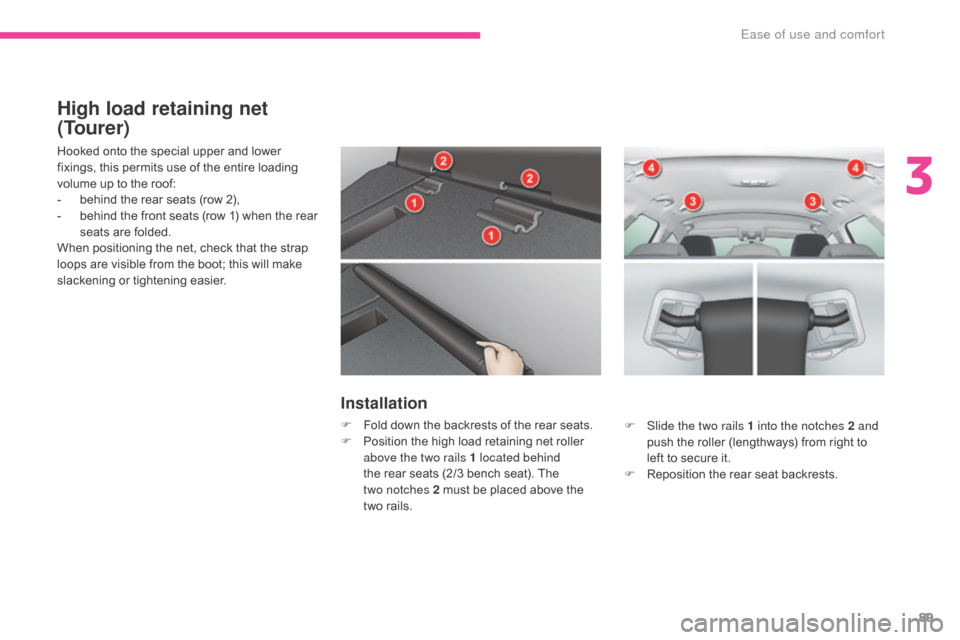
89
C5_en_Chap03_ergonomie-et-confort_ed01-2016
High load retaining net
(Tourer)
Hooked onto the special upper and lower
fixings, this permits use of the entire loading
volume up to the roof:
-
b
ehind the rear seats (row 2),
-
b
ehind the front seats (row 1) when the rear
seats are folded.
When positioning the net, check that the strap
loops are visible from the boot; this will make
slackening or tightening easier.
Installation
F Fold down the backrests of the rear seats.
F P osition the high load retaining net roller
above the two rails 1 located behind
the rear seats (2/3 bench seat). The
two
notches 2 must be placed above the
two
rails. F
S lide the two rails 1 into the notches 2 and
push the roller (lengthways) from right to
left to secure it.
F
R
eposition the rear seat backrests.
3
Ease of use and comfort
Page 92 of 348
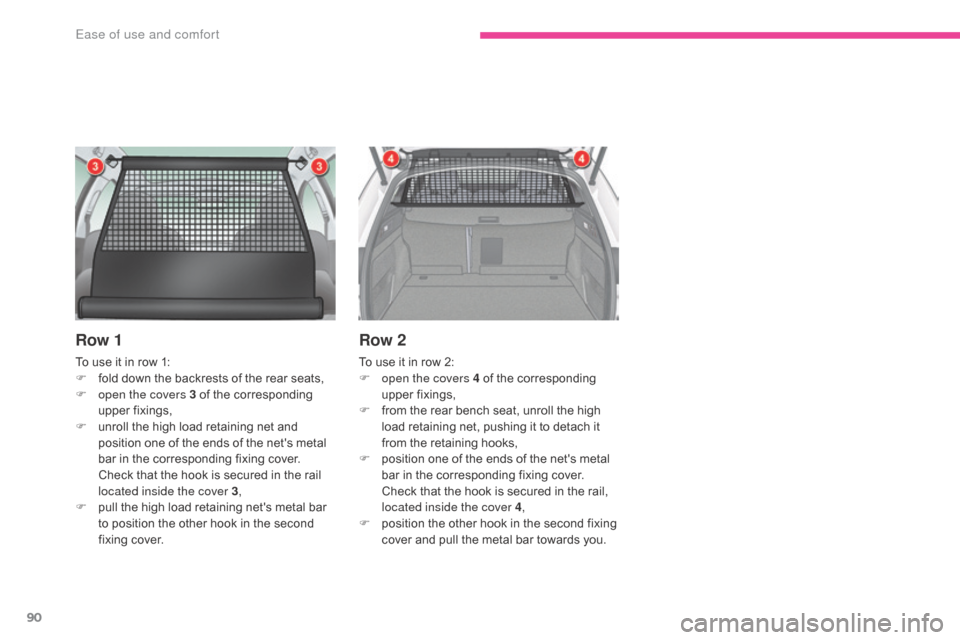
90
C5_en_Chap03_ergonomie-et-confort_ed01-2016
Row 1
To use it in row 1:
F f old down the backrests of the rear seats,
F
o
pen the covers 3 of the corresponding
upper fixings,
F
u
nroll the high load retaining net and
position one of the ends of the net's metal
bar in the corresponding fixing cover.
Check that the hook is secured in the rail
located inside the cover 3 ,
F
p
ull the high load retaining net's metal bar
to position the other hook in the second
fixing cover.
Row 2
To use it in row 2:
F o pen the covers 4 of the corresponding
upper fixings,
F
f
rom the rear bench seat, unroll the high
load retaining net, pushing it to detach it
from the retaining hooks,
F
p
osition one of the ends of the net's metal
bar in the corresponding fixing cover.
Check that the hook is secured in the rail,
located inside the cover 4 ,
F
p
osition the other hook in the second fixing
cover and pull the metal bar towards you.
Ease of use and comfort
Page 93 of 348
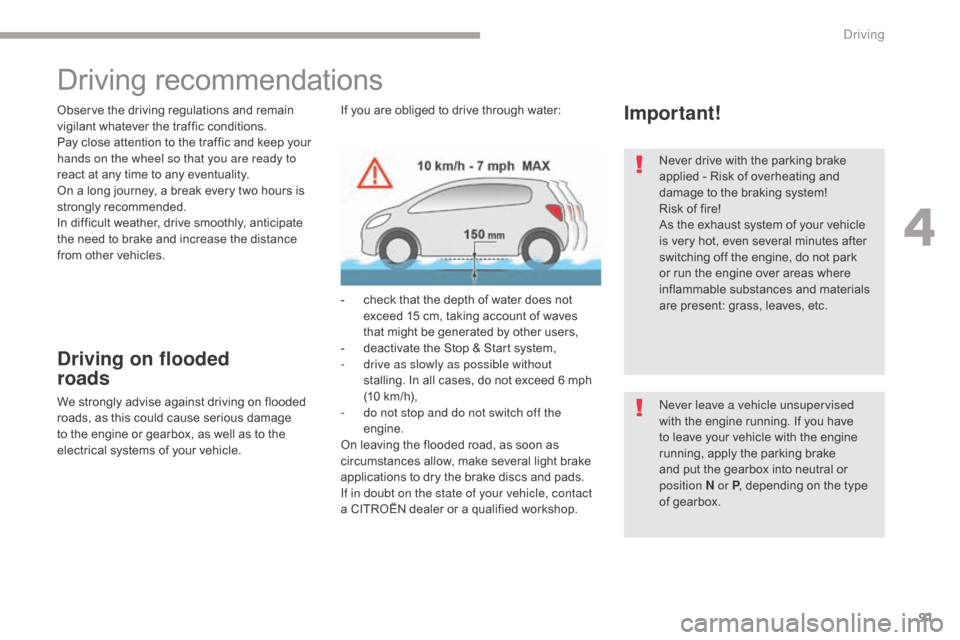
91
C5_en_Chap04_conduite_ed01-2016
Observe the driving regulations and remain
vigilant whatever the traffic conditions.
Pay close attention to the traffic and keep your
hands on the wheel so that you are ready to
react at any time to any eventuality.
On a long journey, a break every two hours is
strongly recommended.
In difficult weather, drive smoothly, anticipate
the need to brake and increase the distance
from other vehicles.
Driving on flooded
roads
We strongly advise against driving on flooded
roads, as this could cause serious damage
to the engine or gearbox, as well as to the
electrical systems of your vehicle.
Driving recommendations
Important!
Never drive with the parking brake
applied - Risk of overheating and
damage to the braking system!
Risk of fire!
As the exhaust system of your vehicle
is very hot, even several minutes after
switching off the engine, do not park
or run the engine over areas where
inflammable substances and materials
are present: grass, leaves, etc.
Never leave a vehicle unsupervised
with the engine running. If you have
to leave your vehicle with the engine
running, apply the parking brake
and put the gearbox into neutral or
position
N or P, depending on the type
of gearbox.
If you are obliged to drive through water:
-
c
heck that the depth of water does not
exceed 15 cm, taking account of waves
that might be generated by other users,
-
d
eactivate the Stop & Start system,
-
d
rive as slowly as possible without
stalling. In all cases, do not exceed 6 mph
(10
km/h),
-
d
o not stop and do not switch off the
engine.
On leaving the flooded road, as soon as
circumstances allow, make several light brake
applications to dry the brake discs and pads.
If in doubt on the state of your vehicle, contact
a CITROËN dealer or a qualified workshop.
4
Driving
Page 94 of 348
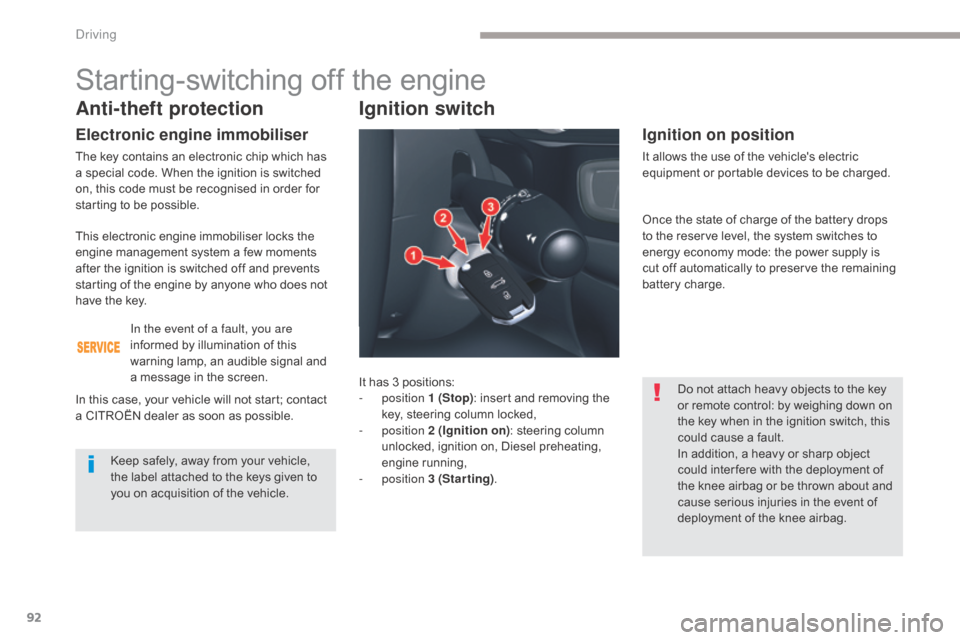
92
C5_en_Chap04_conduite_ed01-2016
Anti-theft protection
Electronic engine immobiliser
The key contains an electronic chip which has
a special code. When the ignition is switched
on, this code must be recognised in order for
starting to be possible.In the event of a fault, you are
informed by illumination of this
warning lamp, an audible signal and
a message in the screen.
In this case, your vehicle will not start; contact
a CITROËN dealer as soon as possible.
Starting-switching off the engine
Keep safely, away from your vehicle,
the label attached to the keys given to
you on acquisition of the vehicle.
Ignition switch
It has 3 positions:
- position 1 (Stop): insert and removing the
key, steering column locked,
-
position 2 (Ignition on) : steering column
unlocked, ignition on, Diesel preheating,
engine running,
-
position 3 (Starting) .
Ignition on position
It allows the use of the vehicle's electric
equipment or portable devices to be charged.
Do not attach heavy objects to the key
or remote control: by weighing down on
the key when in the ignition switch, this
could cause a fault.
In addition, a heavy or sharp object
could inter fere with the deployment of
the knee airbag or be thrown about and
cause serious injuries in the event of
deployment of the knee airbag.
This electronic engine immobiliser locks the
engine management system a few moments
after the ignition is switched off and prevents
starting of the engine by anyone who does not
have the key.
Once the state of charge of the battery drops
to the reserve level, the system switches to
energy economy mode: the power supply is
cut off automatically to preserve the remaining
battery charge.
Driving
Page 95 of 348
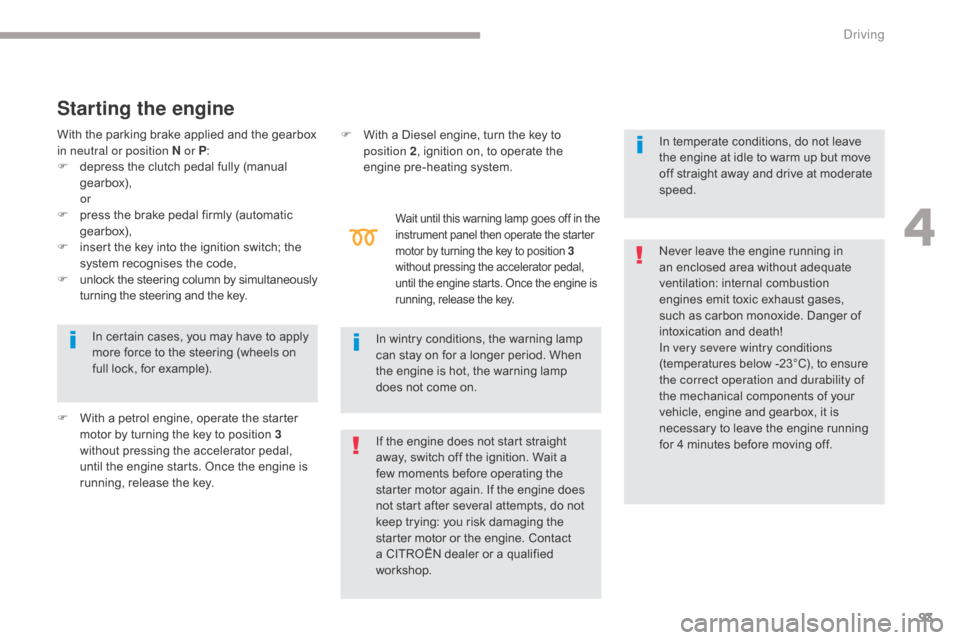
93
C5_en_Chap04_conduite_ed01-2016
Starting the engine
Wait until this warning lamp goes off in the
instrument panel then operate the starter
motor by turning the key to position 3
without pressing the accelerator pedal,
until the engine starts. Once the engine is
running, release the key.
With the parking brake applied and the gearbox
in neutral or position N or P:
F
d
epress the clutch pedal fully (manual
gearbox),
or
F
p
ress the brake pedal firmly (automatic
gearbox),
F
i
nsert the key into the ignition switch; the
system recognises the code,
F
u
nlock the steering column by simultaneously
turning the steering and the key.
F
W
ith a petrol engine, operate the starter
motor by turning the key to position 3
without pressing the accelerator pedal,
until the engine starts. Once the engine is
running, release the key. Never leave the engine running in
an enclosed area without adequate
ventilation: internal combustion
engines emit toxic exhaust gases,
such as carbon monoxide. Danger of
intoxication and death!
In very severe wintry conditions
(temperatures below -23°C), to ensure
the correct operation and durability of
the mechanical components of your
vehicle, engine and gearbox, it is
necessary to leave the engine running
for 4 minutes before moving off.
In wintry conditions, the warning lamp
can stay on for a longer period. When
the engine is hot, the warning lamp
does not come on.
In certain cases, you may have to apply
more force to the steering (wheels on
full lock, for example). F
W ith a Diesel engine, turn the key to
position 2 , ignition on, to operate the
engine pre-heating system.
If the engine does not start straight
away, switch off the ignition. Wait a
few moments before operating the
starter motor again. If the engine does
not start after several attempts, do not
keep trying: you risk damaging the
starter motor or the engine. Contact
a CITROËN dealer or a qualified
workshop. In temperate conditions, do not leave
the engine at idle to warm up but move
off straight away and drive at moderate
speed.
4
Driving
Page 96 of 348
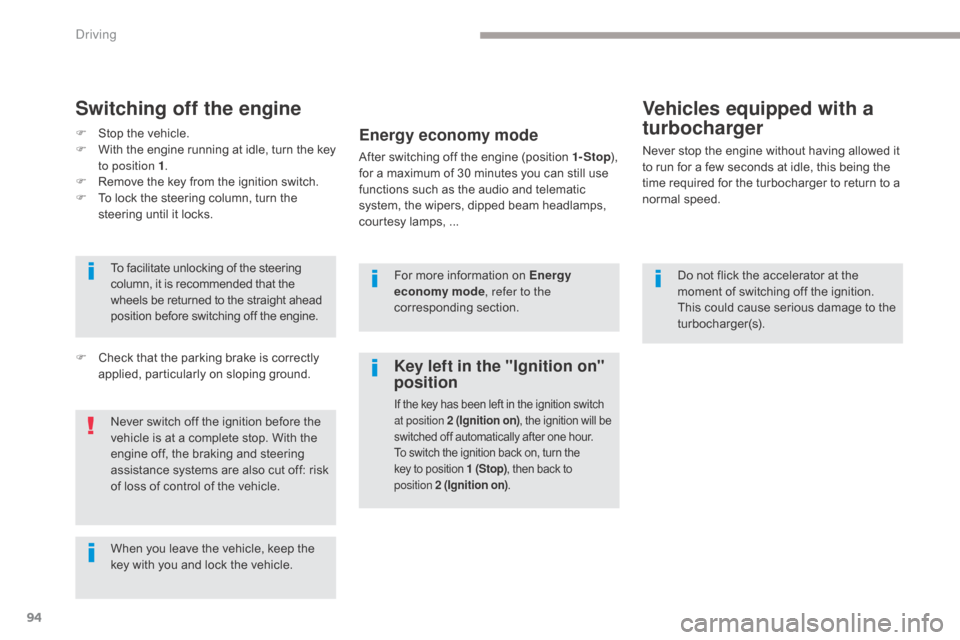
94
C5_en_Chap04_conduite_ed01-2016
Do not flick the accelerator at the
moment of switching off the ignition.
This could cause serious damage to the
turbocharger(s).
Vehicles equipped with a
turbocharger
Never stop the engine without having allowed it
to run for a few seconds at idle, this being the
time required for the turbocharger to return to a
normal speed.Energy economy mode
After switching off the engine (position 1- Stop),
for a maximum of 30 minutes you can still use
functions such as the audio and telematic
system, the wipers, dipped beam headlamps,
courtesy lamps, ...
Switching off the engine
F Stop the vehicle.
F W ith the engine running at idle, turn the key
to position 1 .
F
R
emove the key from the ignition switch.
F
T
o lock the steering column, turn the
steering until it locks.
When you leave the vehicle, keep the
key with you and lock the vehicle. To facilitate unlocking of the steering
column, it is recommended that the
wheels be returned to the straight ahead
position before switching off the engine.
Never switch off the ignition before the
vehicle is at a complete stop. With the
engine off, the braking and steering
assistance systems are also cut off: risk
of loss of control of the vehicle. For more information on Energy
economy mode
, refer to the
corresponding section.
F
C
heck that the parking brake is correctly
applied, particularly on sloping ground.
Key left in the "Ignition on"
position
If the key has been left in the ignition switch
at position 2 (Ignition on) , the ignition will be
switched off automatically after one hour.
To switch the ignition back on, turn the
key to position 1 (Stop) , then back to
position 2 (Ignition on) .
Driving
Page 97 of 348
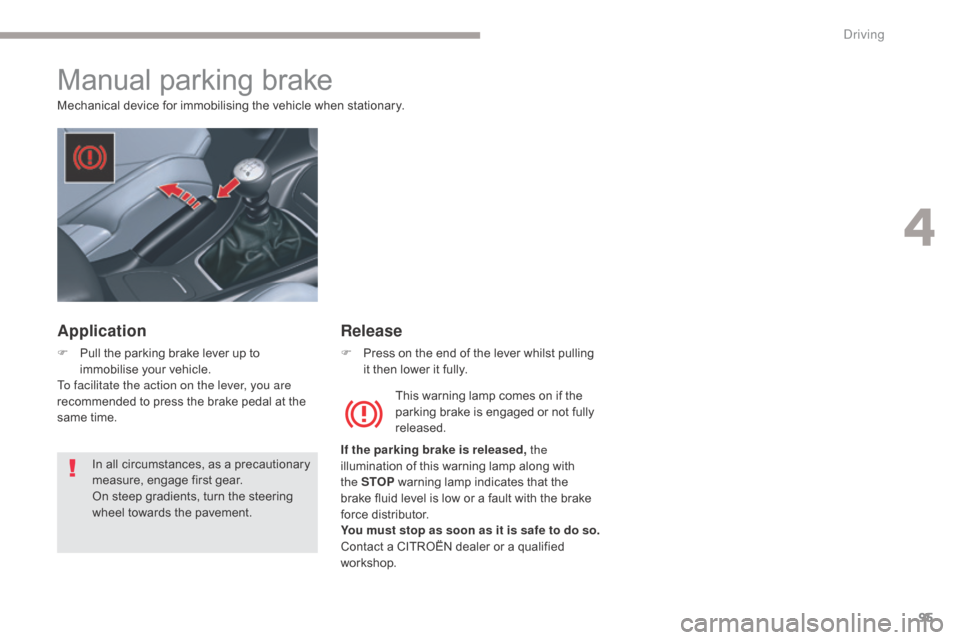
95
C5_en_Chap04_conduite_ed01-2016
Manual parking brake
Mechanical device for immobilising the vehicle when stationary.This warning lamp comes on if the
parking brake is engaged or not fully
released.
If the parking brake is released, the
illumination of this warning lamp along with
the
STOP warning lamp indicates that the
brake fluid level is low or a fault with the brake
force distributor.
You must stop as soon as it is safe to do so.
Contact a CITROËN dealer or a qualified
workshop.
Application
F Pull the parking brake lever up to immobilise your vehicle.
To facilitate the action on the lever, you are
recommended to press the brake pedal at the
same time.
Release
F Press on the end of the lever whilst pulling it then lower it fully.
In all circumstances, as a precautionary
measure, engage first gear.
On steep gradients, turn the steering
wheel towards the pavement.
4
Driving
Page 98 of 348

96
C5_en_Chap04_conduite_ed01-2016
Electric parking brake
The electric parking brake combines
2 operating modes:
Automatic operation
Application with the engine off
With the vehicle stationary, the parking brake
is automatically applied when the engine is
switched off.
The application of the parking brake is
confirmed by:
Application with the engine running
With the engine running and the vehicle
stationary, in order to immobilise the vehicle
you need to manually apply the parking brake
by pulling the control lever A .
The application of the parking brake is
confirmed by:
-
w
arning lamp P in the control
lever A coming on,
-
d
isplay of a message " Parking brake
applied " in the instrument panel screen. -
w
arning lamp P in the control
lever A coming on,
-
d
isplay of a message " Parking brake
applied " in the instrument panel screen.
-
t
his warning lamp in the
instrument panel coming on, -
t
his warning lamp in the
instrument panel coming on,
Before leaving the vehicle, check that
warning lamp P and the warning lamp in
the instrument panel are on.
Never leave a child alone inside the
vehicle with the ignition on, as they
could release the parking brake. Before leaving the vehicle, check that
warning lamp
P and the warning lamp in
the instrument panel are on.
-
A
utomatic
A
utomatic application when the engine
stops and automatic release on use of the
accelerator (activated by default).
-
M
anual
M
anual application / release of the parking
brake is always possible by pulling control
lever A while pressing the brake pedal. When the driver’s door is opened, a beep is
heard and a message displayed if the parking
brake has not been applied.
The noise of operation will confirm to you the
application / release of the electric parking
brake.
Driving
Page 99 of 348
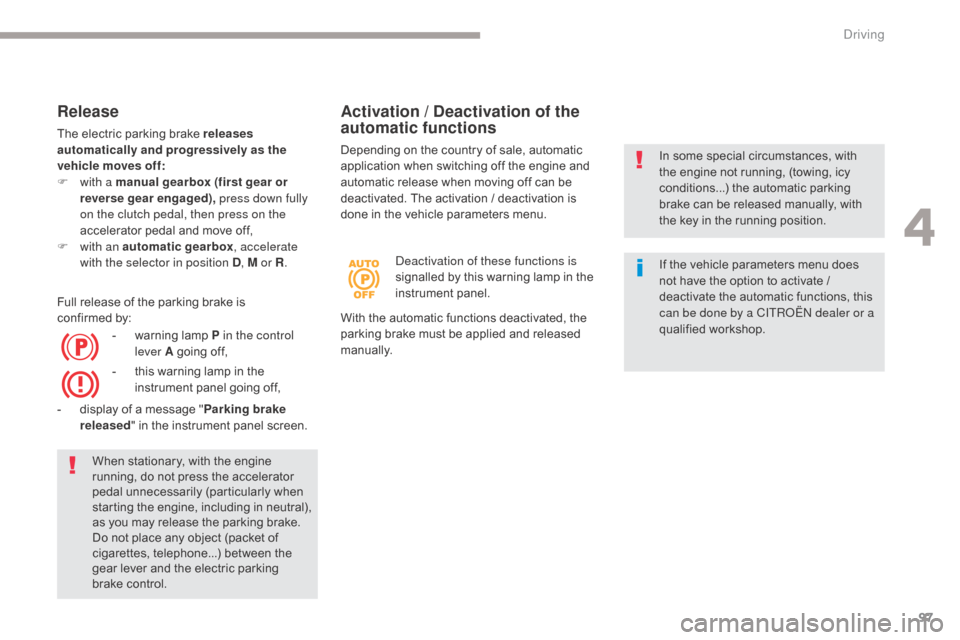
97
C5_en_Chap04_conduite_ed01-2016
Release
The electric parking brake releases
automatically and progressively as the
vehicle moves off :
F
w
ith a manual gearbox (first gear or
reverse gear engaged), press down fully
on the clutch pedal, then press on the
accelerator pedal and move off,
F
w
ith an automatic gearbox , accelerate
with the selector in position D , M or R.
Full release of the parking brake is
confirmed
by:
-
w
arning lamp P in the control
lever A going off,
-
d
isplay of a message " Parking brake
released " in the instrument panel screen.
Activation / Deactivation of the
automatic functions
Depending on the country of sale, automatic
application when switching off the engine and
automatic release when moving off can be
deactivated. The activation / deactivation is
done in the vehicle parameters menu.
Deactivation of these functions is
signalled by this warning lamp in the
instrument panel.
-
t
his warning lamp in the
instrument panel going off, In some special circumstances, with
the engine not running, (towing, icy
conditions...) the automatic parking
brake can be released manually, with
the key in the running position.
If the vehicle parameters menu does
not have the option to activate /
deactivate the automatic functions, this
can be done by a CITROËN dealer or a
qualified workshop.
With the automatic functions deactivated, the
parking brake must be applied and released
manually.
When stationary, with the engine
running, do not press the accelerator
pedal unnecessarily (particularly when
starting the engine, including in neutral),
as you may release the parking brake.
Do not place any object (packet of
cigarettes, telephone...) between the
gear lever and the electric parking
brake control.
4
Driving
Page 100 of 348
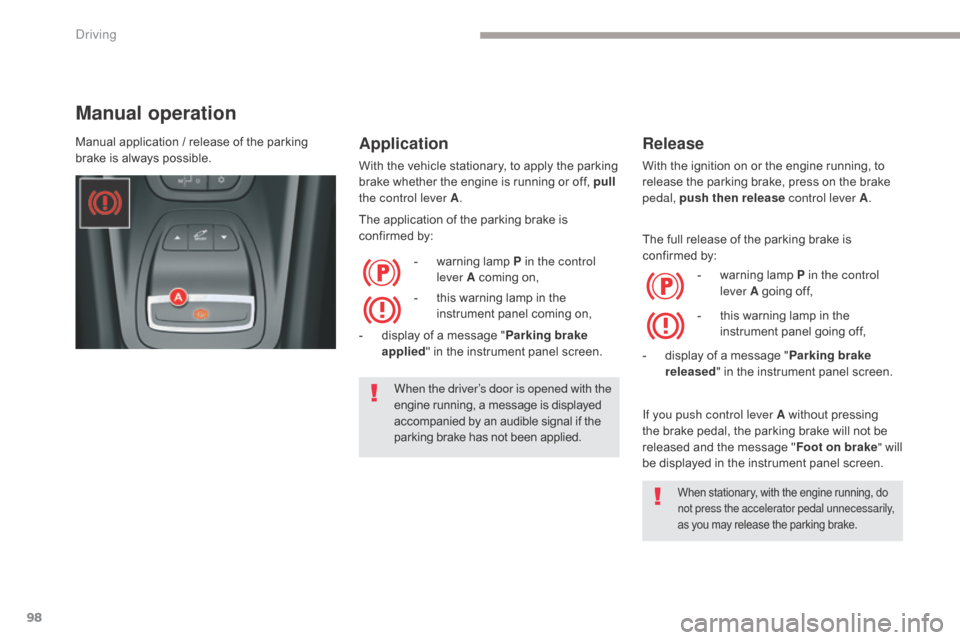
98
C5_en_Chap04_conduite_ed01-2016
Manual operation
Application
With the vehicle stationary, to apply the parking
brake whether the engine is running or off, pull
the control lever A .
The application of the parking brake is
confirmed by:
-
w
arning lamp P in the control
lever A coming on,
-
d
isplay of a message " Parking brake
applied " in the instrument panel screen.
-
t
his warning lamp in the
instrument panel coming on,
When the driver’s door is opened with the
engine running, a message is displayed
accompanied by an audible signal if the
parking brake has not been applied.
Manual application / release of the parking
brake is always possible.
Release
With the ignition on or the engine running, to
release the parking brake, press on the brake
pedal, push then release
control lever A.
The full release of the parking brake is
confirmed by: -
w
arning lamp P in the control
lever A going off,
-
d
isplay of a message " Parking brake
released " in the instrument panel screen.
-
t
his warning lamp in the
instrument panel going off,
When stationary, with the engine running, do
not press the accelerator pedal unnecessarily,
as you may release the parking brake.
If you push control lever A without pressing
the brake pedal, the parking brake will not be
released and the message " Foot on brake" will
be displayed in the instrument panel screen.
Driving